1H NMR and UV-Vis as Analytical Techniques to Evaluate Biodiesel Conversion and Oxidative Stability
Abstract
:1. Introduction
2. Materials and Methods
2.1. Materials
2.2. Biodiesel Production
- malcohol = mass of alcohol (g),
- moil = mass of oil (g),
- MMalcohol = Molar Mass of alcohol (g/mol),
- SI = Saponification Index of oil (mg KOH/g oil),
- AV = Acidity Value of oil (mg KOH/g oil),
- MMKOH = Molar Mass of KOH (g/mol),
- mKOH = mass of KOH (g), and
- purityKOH = purity of KOH (%).
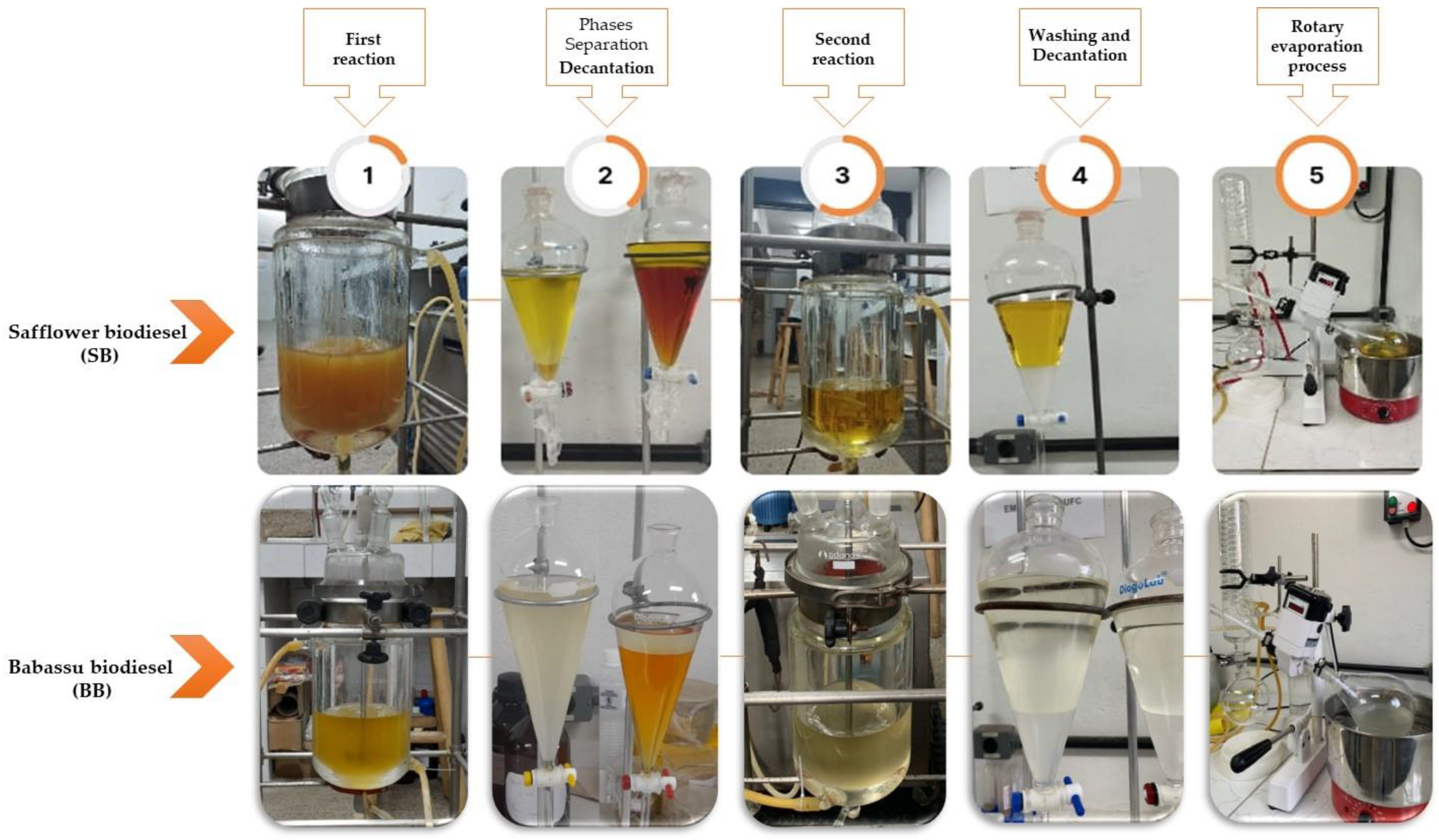
2.3. Physicochemical Properties
2.4. 1H NMR–Biodiesel Conversion and UV-Vis–Oxidative Stability
3. Results
3.1. Physicochemical Properties of the Biodiesel Samples
3.2. Characterization and Evaluation of the Biodiesel Samples using 1H NMR
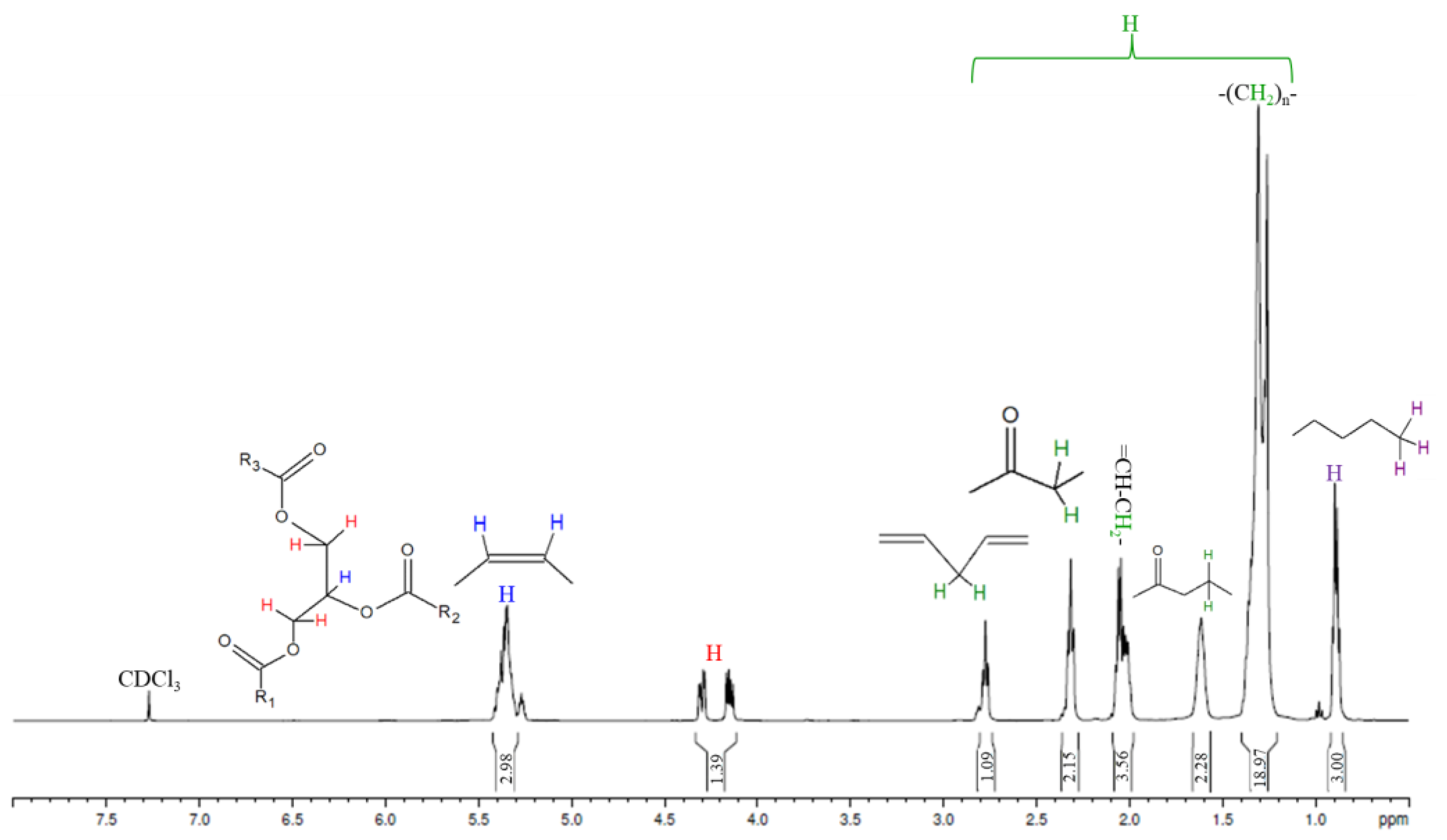

| Molecule | Safflower Oil δ (ppm) | Safflower Biodiesel δ (ppm) |
|---|---|---|
| -CH=CH- Olefinic protons | ~5.3–5.4 | ~5.3–5.4 |
| -CH2OCOR * Methylene group of glycerol | ~4.1–4.3 | - |
| -CH3 Methyl ester | - | ~3.7 |
| =CH-CH2-CH= α-methylene group to two double bond | ~2.7–2.8 | ~2.7–2.8 |
| -COOCH2- α-methylene group to ester | ~2.3 | ~2.2–2.3 |
| =CH-CH2- Methylene group adjacent to double bond | ~2.0–2.1 | ~ 2.0 |
| -COOCH2CH2- β-methylene proton | ~1.6 | ~ 1.6 |
| –(CH2)n- Aliphatic chain | ~1.2–1.3 | ~1.2–1.3 |
| -CH3 Terminal methyl group | ~0.9 | ~0.8–0.9 |

| Sample | Signal δ (ppm) | Peak Area | Conversion |
|---|---|---|---|
| Safflower biodiesel (SB) (Sample 1) | -COOCH2- ~2.2–2.3 | 2.08 | 95.5% ‡ |
| -CH3 ~3.7 | 2.98 | ||
| Safflower biodiesel (SB) (Sample 2) | ~2.3–2.4 | 1.67 | 88.6% ‡‡ |
| ~3.6 | 2.22 | ||
| Mixture 50% (SO):50% (SB) | ~2.3 | 11.68 | 43% |
| ~3.7 | 7.54 | ||
| Mixture 20% (SO):80% (SB) | ~2.3 | 80.37 | 80.4% |
| ~3.6–3.7 | 97.30 |
| Sample | Signal δ (ppm) | Peak Area | Conversion |
|---|---|---|---|
| Babassu biodiesel (BB) | -COOCH2- ~2.2–2.3 | 6.81 | 96.3% ‡ |
| -CH3 ~3.7 | 9.84 |
3.3. Oxidative Stability Monitoring of the Biodiesel Samples using UV-Vis

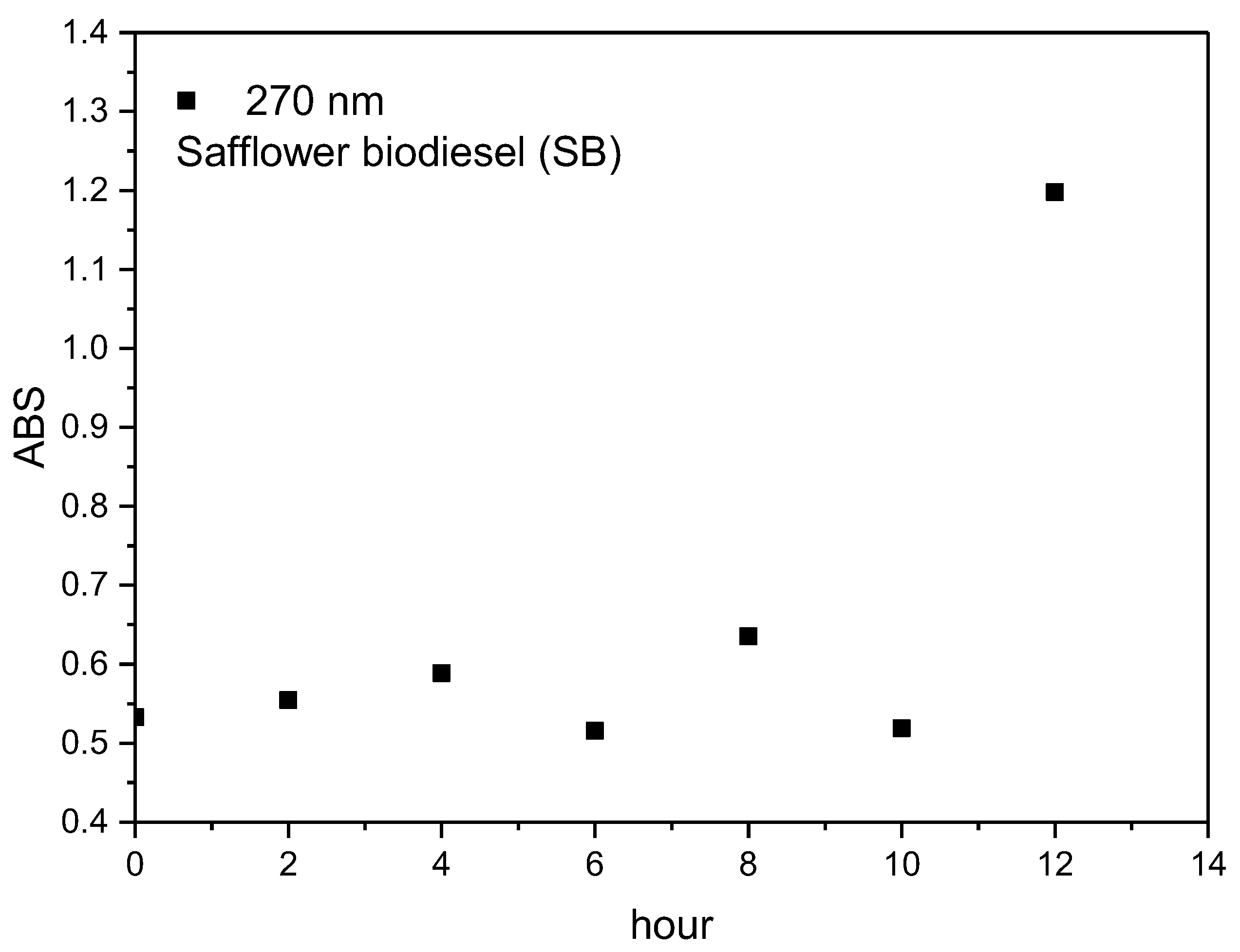
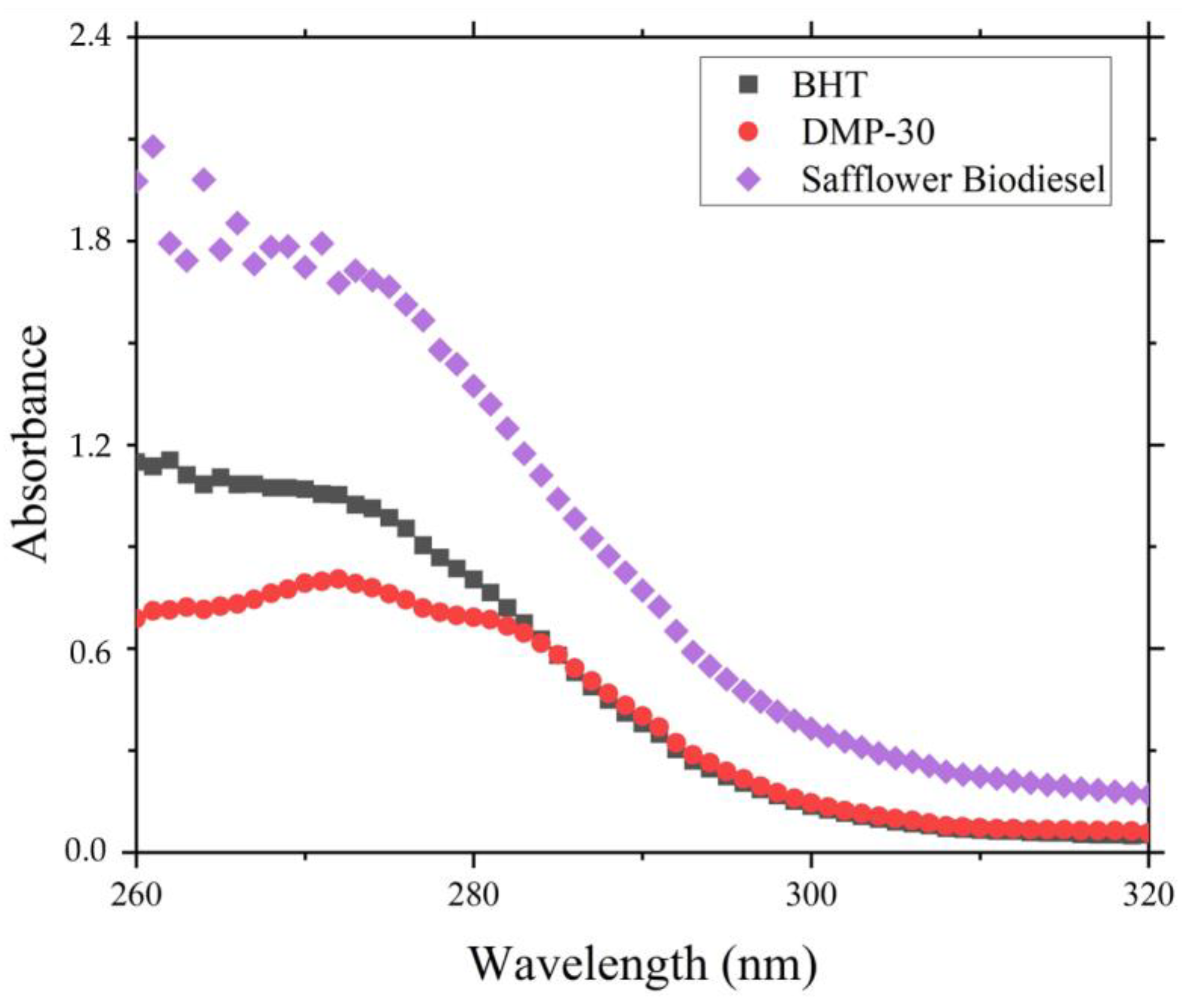
| Sample | Induction Period (h) | Limit ‡, Methods |
|---|---|---|
| Safflower biodiesel (SB) | 3.9 | 13 h, EN 14112 |
| SB + BHT 1000 mg/kg | 6.4 | |
| SB + DMP-30 1000 mg/kg | 26.4 |
| Sample | Rancimat® | UV-Vis (λmax = 270 nm) |
|---|---|---|
| * SB + BHT 1000 mg/kg | 64% | 38% |
| SB + DMP-30 1000 mg/kg | 577% | 54% |
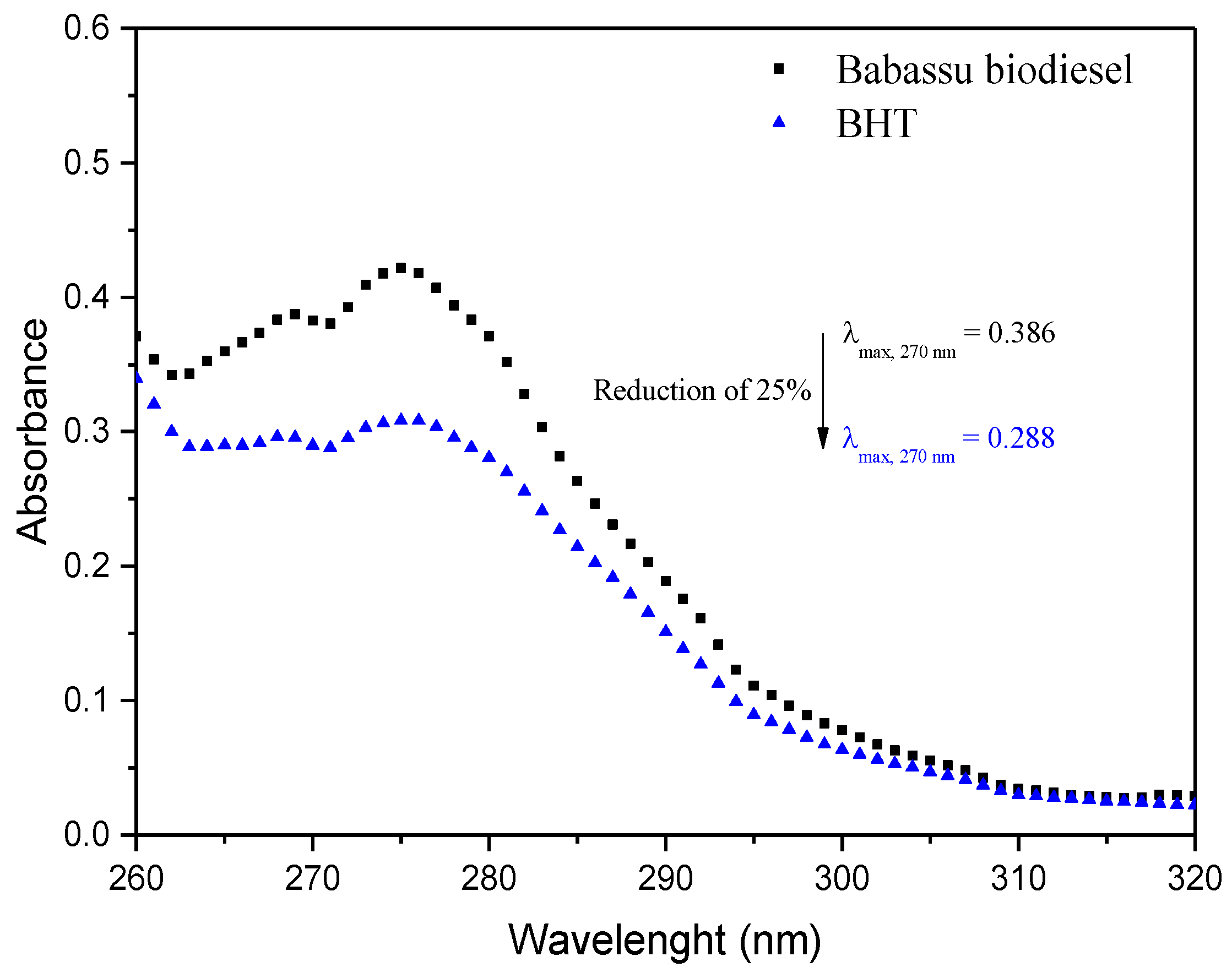
4. Discussion
5. Conclusions
Author Contributions
Funding
Data Availability Statement
Acknowledgments
Conflicts of Interest
References
- Gaurav, K.; Neeti, K.; Singh, R. Microalgae-based biodiesel production and its challenges and future opportunities: A review. Green Technol. Sustain. 2024, 2, 100060. [Google Scholar] [CrossRef]
- Garg, R.; Rana, S.; Ahmadipour, M. From waste to fuel: Challenging aspects in sustainable biodiesel production from lignocellulosic biomass feedstocks and role of metal organic framework as innovative heterogeneous catalysts. Ind. Crops Prod. 2023, 206, 117554. [Google Scholar] [CrossRef]
- Khujamberdiev, R.; Cho, H.M.; Mahmud, M.I. Experimental Investigation of Single-Cylinder Engine Performance Using Biodiesel Made from Waste Swine Oil. Energies 2023, 16, 7891. [Google Scholar] [CrossRef]
- Sambasivam, K.M.; Kuppan, P.; Laila, L.S.; Shashirekha, V.; Tamilarasan, K.; Abinandan, S. Kernel-Based Biodiesel Production from Non-Edible Oil Seeds: Techniques, Optimization, and Environmental Implications. Energies 2023, 16, 7589. [Google Scholar] [CrossRef]
- Sales, M.B.; Borges, P.T.; Ribeiro Filho, M.N.; Miranda da Silva, L.R.; Castro, A.P.; Sanders Lopes, A.A.; Chaves de Lima, R.K.; de Sousa Rios, M.A.; Santos, J.C.S.d. Sustainable Feedstocks and Challenges in Biodiesel Production: An Advanced Bibliometric Analysis. Bioengineering 2022, 9, 539. [Google Scholar] [CrossRef] [PubMed]
- Rangel, N.V.P.; Silva, L.P.; Pinheiro, V.S.; Figueredo, I.M.; Campos, O.S.; Costa, S.N.; Luna, F.M.T.; Cavalcante, C.L., Jr.; Marinho, E.S.; Lima-Neto, P.; et al. Effect of additives on the oxidative stability and corrosivity of biodiesel samples derived from babassu oil and residual frying oil: An experimental and theoretical assessment. Fuel 2021, 289, 119939. [Google Scholar] [CrossRef]
- Alexandre, J.Y.N.H.; Cavalcante, F.T.T.; Freitas, L.M.; Castro, A.P.; Borges, P.T.; de Sousa Junior, P.G.; Filho, M.N.R.; Lopes, A.A.S.; da Fonseca, A.M.; Lomonaco, D.; et al. A Theoretical and Experimental Study for Enzymatic Biodiesel Production from Babassu Oil (Orbignya sp.) Using Eversa Lipase. Catalysts 2022, 12, 1322. [Google Scholar] [CrossRef]
- Kurczyński, D.; Wcisło, G.; Łagowski, P.; Leśniak, A.; Kozak, M.; Pracuch, B. Determination of the Effect of the Addition of Second-Generation Biodiesel BBuE to Diesel Fuel on Selected Parameters of “B” Fuels. Energies 2023, 16, 6999. [Google Scholar] [CrossRef]
- National Agency of Petroleum, Natural Gas and Biofuels (ANP) Resolution (920/2023). Available online: https://www.gov.br/anp/pt-br/canais_atendimento/imprensa/noticias-comunicados/anp-vai-revisar-resolucao-sobre-especificacao-do-biodiesel (accessed on 10 December 2023).
- Manikandan, G.; Kanna, P.R.; Taler, D.; Sobota, T. Review of Waste Cooking Oil (WCO) as a Feedstock for Biofuel—Indian Perspective. Energies 2023, 16, 1739. [Google Scholar] [CrossRef]
- de Ávila, M.T.; Cabezas-Gómez, L.; Cruz Cabezas, L.M.; Pereira de Souza, S.; Shrestha, D.S. Use of Soybean Oil like as Fuel for Diesel Cycle Engine. Semin. Ciênc. Exatas Tecnol. 2023, 44, e48045. [Google Scholar] [CrossRef]
- Kaya, T.; Kutlar, O.A.; Taskiran, O.O. Evaluation of the Effects of Biodiesel on Emissions and Performance by Comparing the Results of the New European Drive Cycle and Worldwide Harmonized Light Vehicles Test Cycle. Energies 2018, 11, 2814. [Google Scholar] [CrossRef]
- Yan, Y.; Liu, Z.; Liu, J. An Evaluation of the Conversion of Gasoline and Natural Gas Spark Ignition Engines to Ammonia/Hydrogen Operation From the Perspective of Laminar Flame Speed. ASME. J. Energy Resour. Technol. 2023, 145, 012302. [Google Scholar] [CrossRef]
- Liu, Z.; Liu, J. Machine Learning Assisted Analysis of an Ammonia Engine Performance. ASME. J. Energy Resour. Technol. 2022, 144, 112307. [Google Scholar] [CrossRef]
- Sousa, L.S.; Garcia, M.A.S.; Santos, E.C.P.; Silva, J.N.; Castro, A.G.; Moura, C.V.R.; Moura, E.M. Study of the kinetic and thermodynamic parameters of the oxidative degradation process of biodiesel by the action of antioxidants using the Rancimat and PetroOXY methods. Fuel 2019, 238, 198–207. [Google Scholar] [CrossRef]
- Nogueira, T.R.; Figueredo, I.M.; Luna, F.M.T.; Cavalcante, C.L., Jr.; Santos, J.E.A.; Lima, M.A.S.; Silva, T.S.J.; Leal, L.K.A.M.; Nunes, F.M.; Rios, M.A.S.; et al. Evaluation of oxidative stability of soybean biodiesel using ethanolic and chloroform extracts of Platymiscium floribundum as antioxidant. Renew. Energy 2020, 159, 767–774. [Google Scholar] [CrossRef]
- Monyem, A.; Van Gerpen, J.H. The effect of biodiesel oxidation on engine performance and emissions. Biomass Bioenergy 2001, 20, 317–325. [Google Scholar] [CrossRef]
- Venkatesan, E.P.; Rajendran, S.; Murugan, M.; Medapati, S.R.; Murthy, K.V.; Sri, R.; Alwetaishi, M.; Khan, S.A.; Saleel, C.A. Performance and Emission Analysis of Biodiesel Blends in a Low Heat Rejection Engine with an Antioxidant Additive: An Experimental Study. ACS Omega 2023, 8, 36686–36699. [Google Scholar] [CrossRef] [PubMed]
- Thompson, C.J.; Peterson, L.C.; Reece, L.D.; Beck, M.S. Two years storage study with methyl and ethyl esters of rapeseed. In Liquid Fuels and Industrial Products from Renewable Resources, Proceedings of the Third Liquid Fuels Conference, Nashville, TN, USA, 15–17 September 1996; Cundiff, J., Ed.; American Society of Agricultural and Biological Engineers: St. Joseph, MI, USA, 1996. [Google Scholar]
- Zuleta, E.C.; Baena, L.; Rios, L.A.; Calderón, J.A. The Oxidative Stability of Biodiesel and its Impact on the Deterioration of Metallic and Polymeric Materials: A Review. J. Braz. Chem. Soc. 2012, 23, 2159–2175. [Google Scholar] [CrossRef]
- Hinterberger, E.; Ackerly, E.; Chen, Y.; Li, Y.C. Development of a Low-Cost and Versatile Gas Chromatography System for Teaching Analytical Chemistry. J. Chem. Educ. 2021, 98, 4074–4077. [Google Scholar] [CrossRef]
- Siddiqui, M.R.; AlOthman, Z.A.; Rahman, N. Analytical techniques in pharmaceutical analysis: A review. Arab. J. Chem. 2017, 10, S1409–S1421. [Google Scholar] [CrossRef]
- Ekoume, F.P.; Boersma, H.H.; Dong À Zok, F.; Rubow, S.M. Validation of a cost-effective alternative for a radiochromatography method to be used in a developing country. EJNMMI Radiopharm. Chem. 2020, 5, 9. [Google Scholar] [CrossRef] [PubMed]
- González-Morales, D.; Valencia, A.; Díaz-Nuñez, A.; Fuentes-Estrada, M.; López-Santos, O.; García-Beltrán, O. Development of a Low-Cost UV-Vis Spectrophotometer and Its Application for the Detection of Mercuric Ions Assisted by Chemosensors. Sensors 2020, 20, 906. [Google Scholar] [CrossRef] [PubMed]
- Doudin, K.I. Quantitative and qualitative analysis of biodiesel by NMR spectroscopic methods. Fuel 2021, 284, 119114. [Google Scholar] [CrossRef]
- Knothe, G. Determining the blend level of mixtures of biodiesel with conventional diesel fuel by fiber-optic near-infrared spectroscopy and 1H nuclear magnetic resonance spectroscopy. J. Amer. Oil Chem. Soc. 2001, 78, 1025–1028. [Google Scholar] [CrossRef]
- Portela, N.A.; Oliveira, E.C.S.; Neto, A.C.; Rodrigues, R.R.T.; Silva, S.R.C.; Castro, E.V.R.; Filgueiras, P.R. Quantification of biodiesel in petroleum diesel by 1H NMR: Evaluation of univariate and multivariate approaches. Fuel 2016, 166, 12–18. [Google Scholar] [CrossRef]
- Ng, M.H.; Yung, C.L. Nuclear magnetic resonance spectroscopic characterisation of palm biodiesel and its blends. Fuel 2019, 257, 116008. [Google Scholar] [CrossRef]
- Hsieh, L.-Y.; Chan, H.-H.; Kuo, P.-C.; Hung, H.-Y.; Li, Y.-C.; Kuo, C.-L.; Peng, Y.; Zhao, Z.-Z.; Kuo, D.-H.; Sun, I.-W.; et al. A feasible and practical 1H NMR analytical method for the quality control and quantification of bioactive principles in Lycii Fructus. J. Food Compost. Anal. 2018, 26, 1105–1112. [Google Scholar] [CrossRef] [PubMed]
- Gelbard, G.; Brès, O.; Vargas, R.M.; Vielfaure, F.; Schuchardt, U.F. 1H nuclear magnetic resonance determination of the yield of the transesterification of rapeseed oil with methanol. J. Amer. Oil Chem. Soc. 1995, 72, 1239–1241. [Google Scholar] [CrossRef]
- Rodrigues, E.; Brasil, H.; Barros, T.; Pereira, C.; Reis, M.A.L.; Almeida, O. Síntese e caracterização do material hidrotalcita-hidroxiapatita dopado com nanotubos de carbono e sua aplicação na catálise da reação de transesterificação. Cerâmica 2018, 64, 166–175. [Google Scholar] [CrossRef]
- Morgenstern, M.; Cline, J.; Meyer, S.; Cataldo, S. Determination of the Kinetics of Biodiesel Production Using Proton Nuclear Magnetic Resonance Spectroscopy (1H NMR). Energy Fuels 2006, 20, 1350–1353. [Google Scholar] [CrossRef]
- Orozco, F.D.A.; Sousa, A.C.; Araujo, M.C.U.; Domini, C.E. A new flow UV–Vis kinetics spectrophotometric method based on a photodegradative reaction for determining the oxidative stability of biodiesel. Fuel 2020, 262, 116197. [Google Scholar] [CrossRef]
- Deviren, H.; Aydın, H. Production and physicochemical properties of safflower seed oil extracted using different methods and its conversion to biodiesel. Fuel 2023, 343, 128001. [Google Scholar] [CrossRef]
- Satyarthi, J.K.; Srinivas, D.; Ratnasamy, P. Estimation of Free Fatty Acid Content in Oils, Fats, and Biodiesel by 1H NMR Spectroscopy. Energy Fuels 2009, 23, 2273–2277. [Google Scholar] [CrossRef]
- Avila Orozco, F.D.; Sousa, A.C.; Ugulino Araujo, M.C.; Domini, C.E. An ultrasonic-accelerated oxidation method for determining the oxidative stability of biodiesel. Ultrason. Sonochem. 2013, 20, 820–825. [Google Scholar] [CrossRef]
- Camilo, V.M.A.; Almeida, D.T.; Araújo, M.P.N.; Cardoso, L.A.; Andrade, J.C.; Bonelli, M. Avaliação da qualidade de óleos e gorduras de fritura em bares, restaurantes e lanchonetes. Rev. Inst. Adolfo Lutz 2010, 69, 91–98. [Google Scholar] [CrossRef]
- Figueredo, I.M.; Rios, M.A.S.; Cavalcante Junior, C.L.; Luna, F.M.T. Effects of amine and phenolic based antioxidants on the stability of Babassu biodiesel using Rancimat and Differential Scanning Calorimetry techniques. Ind. Eng. Chem. Res. 2020, 50, 18–24. [Google Scholar] [CrossRef]
- Ramírez-Verduzco, L.F.; Hernández-Sánchez, M.J. Group contribution method for predicting viscosity of alkyl esters and biodiesel. Fuel 2024, 357, 129666. [Google Scholar] [CrossRef]
- Meraz, R.M.; Rahman, M.M.; Hassan, T.; Al Rifat, A.; Adib, A.R. A review on algae biodiesel as an automotive fuel. Bioresour. Technol. Rep. 2023, 24, 101659. [Google Scholar] [CrossRef]
- Mantovani, A.C.G.; Chendynski, L.T.; Galvan, D.; Macedo Júnior, F.C.; Borsato, D.; Di Mauro, E. Thermal-oxidation study of biodiesel by proton nuclear magnetic Resonance (1H NMR). Fuel 2020, 274, 117833. [Google Scholar] [CrossRef]
- Nascimento, T.L.; Maciel, M.A.M.; Gurgel, H.E.S.; Rios, M.A.S.; Bertini, L.M. O biodiesel na matriz energética brasileira: Da sua inserção aos dias atuais. Rev. Principia 2023, 60, 593–609. [Google Scholar] [CrossRef]
- Koch, J.D.; Gronki, J.; Hanson, R.K. Measurements of near-UV absorption spectra of acetone and 3-pentanone at high temperatures. J. Quant. Spectrosc. Radiat. Transf. 2008, 109, 2037–2044. [Google Scholar] [CrossRef]
- Dantas, M.B.; Albuquerque, A.R.; Barros, A.K.; Rodrigues Filho, M.G.; Antoniosi Filho, N.R.; Sinfrônio, F.S.M.; Rosenhaim, R.; Soledade, L.E.B.; Santos, I.M.G.; Souza, A.G. Evaluation of the oxidative stability of corn biodiesel. Fuel 2011, 90, 773–778. [Google Scholar] [CrossRef]
- Wang, W.; Li, F.; Wang, H. Study of light wavelength on the oxidative stability of Jatropha biodiesel. Fuel 2021, 292, 120230. [Google Scholar] [CrossRef]
- Pinto, A.C.; Guarieiro, L.L.N.; Rezende, M.J.C.; Ribeiro, N.M.; Torres, E.A.; Lopes, W.A.; Pereira, P.A.P.; Andrade, J.B. Biodiesel: An overview. J. Braz. Chem. Soc. 2005, 16, 1313–1330. [Google Scholar] [CrossRef]
- Nepomuceno, F.H.; Almeida, L.R.; Batista, F.S.C.L.; Rios, M.A.S. UV-Visible Spectroscopy Study of Oxidative Degradation of Sunflower Biodiesel. Energy Sci. Technol. 2011, 2, 56–61. [Google Scholar] [CrossRef]
- Borsato, D.; Cini, J.R.M.; Silva, H.C.; Coppo, R.L.; Angilelli, K.G.; Moreira, I.; Maia, E.C.R. Oxidation kinetics of biodiesel from soybean mixed with synthetic antioxidants BHA, BHT and TBHQ: Determination of activation energy. Fuel Process. Technol. 2014, 127, 111–116. [Google Scholar] [CrossRef]
- Thomas, C.E.; Huber, E.W.; Ohlweiler, D.F. Hydroxyl and Peroxyl Radical Trapping by the Monoamine Oxidase-B Inhibitors deprenyl and MDL 72,974A: Implications for Protection of Biological Substrates. Free Radic. Biol. Med. 1997, 22, 733–737. [Google Scholar] [CrossRef]
- Nakai, S.; Yoneda, F. A theoretical investigation of (−)-deprenyl (selegiline) as a radical scavenger. Theor. Chem. Acc. 2000, 104, 398–406. [Google Scholar] [CrossRef]
- Rashed, M.M.; Masjuki, H.H.; Kalam, M.A.; Alabdulkarem, A.; Rahman, M.M.; Imdadul, H.K.; Rashedul, H.K. Study of the oxidation stability and exhaust emission analysis of Moringa olifera biodiesel in a multi-cylinder diesel engine with aromatic amine antioxidants. Renew. Energy 2016, 94, 294–303. [Google Scholar] [CrossRef]
- Zhao, W.; An, L.; Wang, S. Recyclable High-Performance Epoxy-Anhydride Resins with DMP-30 as the Catalyst of Transesterification Reactions. Polymers 2021, 13, 296. [Google Scholar] [CrossRef]
- Hosseinzadeh-Bandbafha, H.; Kumar, D.; Singh, B.; Shahbeig, H.; Lam, S.S.; Aghbashlo, M.; Tabatabaei, M. Biodiesel antioxidants and their impact on the behavior of diesel engines: A comprehensive review. Fuel Process. Technol. 2022, 232, 107264. [Google Scholar] [CrossRef]
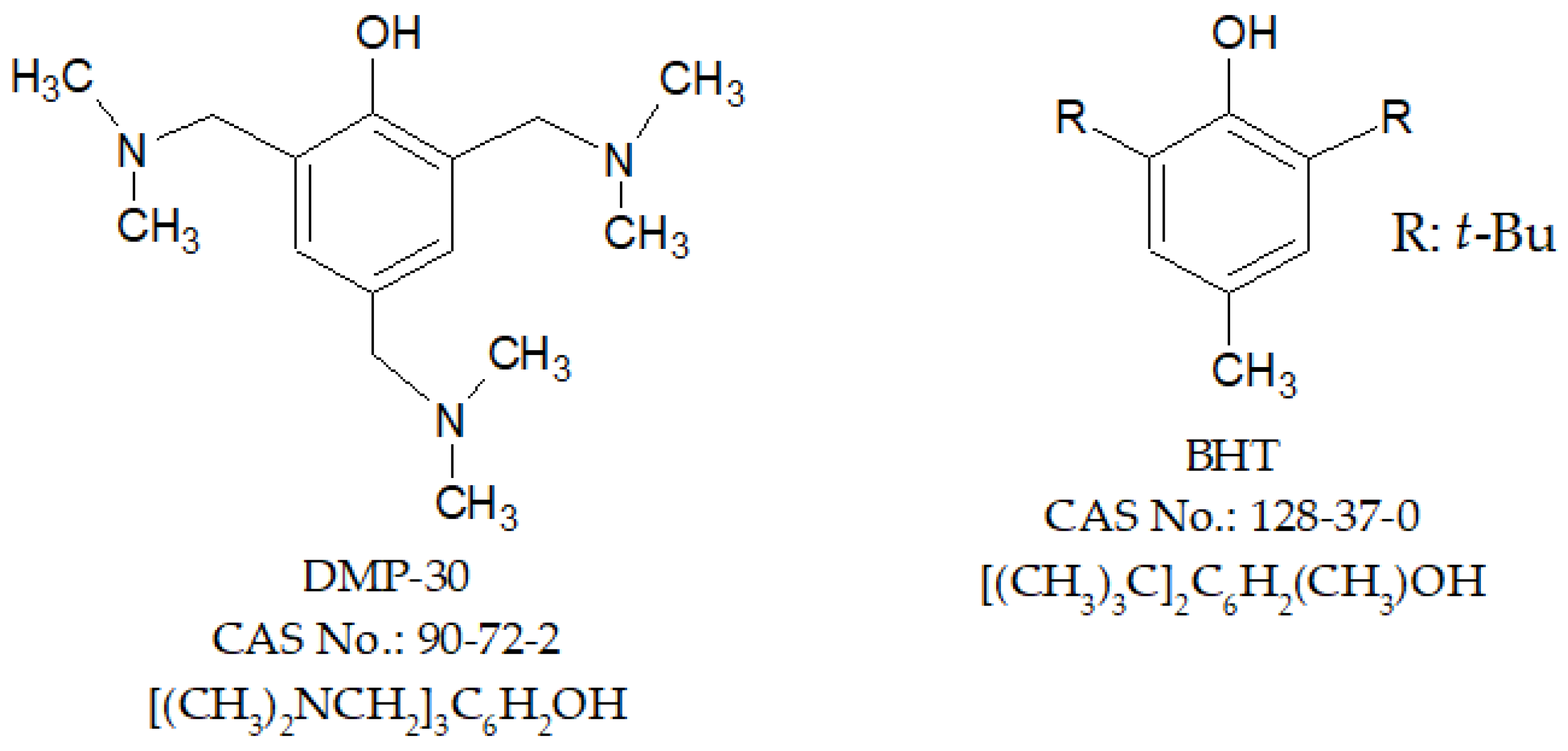
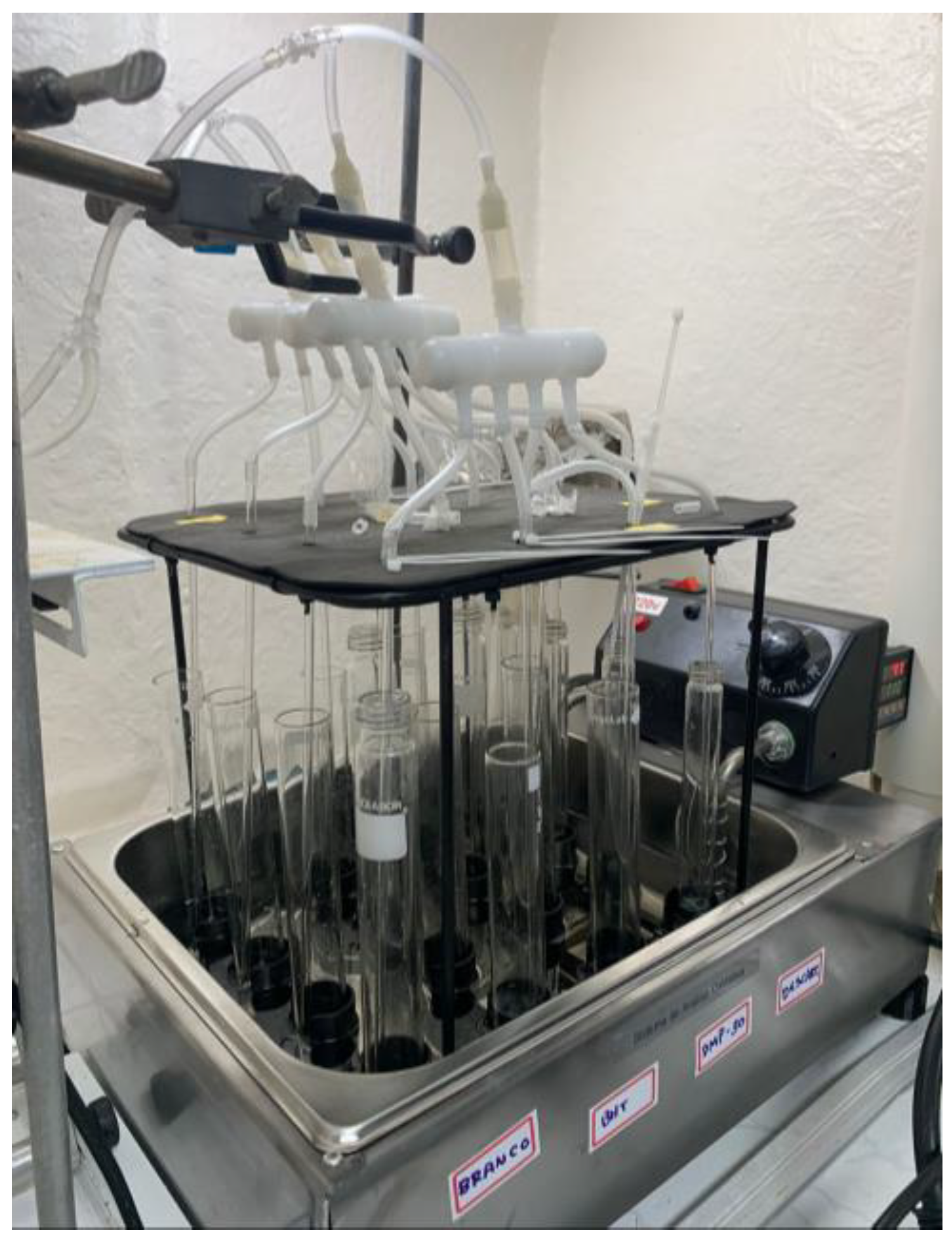
| Properties | Results | Limits *, Methods | |
|---|---|---|---|
| SB | BB | ||
| Density (20 °C), kg/m3 | 881 | 877 | 850–900, ASTM D 4052 |
| Kinematic viscosity (40 °C), mm2/s | 4.2 | 3.6 | 3.0–5.0, ASTM D 445 |
| Acidity value, mg KOH/g | 0.4 | 0.3 | Max 0.5, AOCS Cd 3d-63 |
Disclaimer/Publisher’s Note: The statements, opinions and data contained in all publications are solely those of the individual author(s) and contributor(s) and not of MDPI and/or the editor(s). MDPI and/or the editor(s) disclaim responsibility for any injury to people or property resulting from any ideas, methods, instructions or products referred to in the content. |
© 2024 by the authors. Licensee MDPI, Basel, Switzerland. This article is an open access article distributed under the terms and conditions of the Creative Commons Attribution (CC BY) license (https://creativecommons.org/licenses/by/4.0/).
Share and Cite
Braga, E.; Damasceno, L.; Barros de Sousa Silva, C.; Silva, L.; Cavalcante, M.; Barreto, C.; Silva, S.; Murilo Tavares de Luna, F.; Bertini, L.; Nascimento, T.; et al. 1H NMR and UV-Vis as Analytical Techniques to Evaluate Biodiesel Conversion and Oxidative Stability. Fuels 2024, 5, 107-122. https://doi.org/10.3390/fuels5010007
Braga E, Damasceno L, Barros de Sousa Silva C, Silva L, Cavalcante M, Barreto C, Silva S, Murilo Tavares de Luna F, Bertini L, Nascimento T, et al. 1H NMR and UV-Vis as Analytical Techniques to Evaluate Biodiesel Conversion and Oxidative Stability. Fuels. 2024; 5(1):107-122. https://doi.org/10.3390/fuels5010007
Chicago/Turabian StyleBraga, Emanuelle, Luana Damasceno, Chastryane Barros de Sousa Silva, Lucas Silva, Maria Cavalcante, César Barreto, Silvia Silva, Francisco Murilo Tavares de Luna, Luciana Bertini, Tassio Nascimento, and et al. 2024. "1H NMR and UV-Vis as Analytical Techniques to Evaluate Biodiesel Conversion and Oxidative Stability" Fuels 5, no. 1: 107-122. https://doi.org/10.3390/fuels5010007






